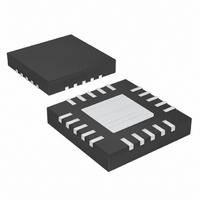MAX9701ETG+ Maxim Integrated Products, MAX9701ETG+ Datasheet - Page 13

MAX9701ETG+
Manufacturer Part Number
MAX9701ETG+
Description
IC AMP AUDIO PWR 2.2W D 24TQFN
Manufacturer
Maxim Integrated Products
Type
Class Dr
Datasheet
1.MAX9701EBPTG45.pdf
(22 pages)
Specifications of MAX9701ETG+
Output Type
2-Channel (Stereo)
Max Output Power X Channels @ Load
2.2W x 2 @ 4 Ohm
Voltage - Supply
2.5 V ~ 5.5 V
Features
Depop, Differential Inputs, Short-Circuit and Thermal Protection, Shutdown
Mounting Type
Surface Mount
Package / Case
24-TQFN Exposed Pad
Product
Class-D
Output Power
1.3 W
Common Mode Rejection Ratio (min)
66 dB
Thd Plus Noise
0.1 %
Supply Current
6.3 mA
Maximum Power Dissipation
1666.7 mW
Maximum Operating Temperature
+ 85 C
Mounting Style
SMD/SMT
Audio Load Resistance
8 Ohms
Minimum Operating Temperature
- 40 C
Amplifier Class
D
No. Of Channels
2
Supply Voltage Range
2.5V To 5.5V
Load Impedance
8ohm
Operating Temperature Range
-40°C To +85°C
Amplifier Case Style
TQFN
Rohs Compliant
Yes
Lead Free Status / RoHS Status
Lead free / RoHS Compliant
Figure 5. MAX9701 Efficiency vs. Class AB Efficiency
The theoretical best efficiency of a linear amplifier is
78%; however, that efficiency is only exhibited at peak
output powers. Under normal operating levels (typical
music reproduction levels), efficiency falls below 30%,
whereas the MAX9701 still exhibits >80% efficiencies
under the same conditions (Figure 5).
The MAX9701 has a shutdown mode that reduces power
consumption and extends battery life. Driving SHDN low
places the MAX9701 in a low-power (0.1μA) shutdown
mode. Connect SHDN to V
The MAX9701 features comprehensive click-and-pop
suppression that eliminates audible transients on startup
and shutdown. While in shutdown, the H-bridge is in a
high-impedance state. During startup, or power-up, the
input amplifiers are muted and an internal loop sets the
modulator bias voltages to the correct levels, preventing
clicks and pops when the H-bridge is subsequently
enabled. For 40ms following startup, a soft-start function
gradually unmutes the input amplifiers.
Traditional Class D amplifiers require an output filter to
recover the audio signal from the amplifier’s PWM out-
put. The filters add cost, increase the solution size of
the amplifier, and can decrease efficiency. The tradi-
tional PWM scheme uses large differential output
swings (2 x V
Any parasitic resistance in the filter components results
in a loss of power, lowering the efficiency.
100
90
80
70
60
50
40
30
20
10
DD(P-P)
0
0
Applications Information
EFFICIENCY vs. OUTPUT POWER
______________________________________________________________________________________
) and causes large ripple currents.
0.1
Click-and-Pop Suppression
MAX9701
OUTPUT POWER (W)
1.3W, Filterless, Stereo Class D Audio
DD
0.2
CLASS AB
for normal operation.
Filterless Operation
0.3
V
f = 1kHz
R
DD
L
0.4
- 8Ω
= 3.3V
Shutdown
0.5
The MAX9701 does not require an output filter. The
device relies on the inherent inductance of the speaker
coil and the natural filtering of both the speaker and the
human ear to recover the audio component of the
square-wave output. Eliminating the output filter results
in a smaller, less costly, more efficient solution.
Because the frequency of the MAX9701 output is well
beyond the bandwidth of most speakers, voice coil
movement due to the square-wave frequency is very
small. Although this movement is small, a speaker not
designed to handle the additional power can be dam-
aged. For optimum results, use a speaker with a series
inductance >10μH. Typical 8Ω speakers, for portable
audio applications, exhibit series inductances in the
range of 20μH to 100μH.
Unlike a Class AB amplifier, the output offset voltage of a
Class D amplifier does not noticeably increase quiescent
current draw when a load is applied. This is due to the
power conversion of the Class D amplifier. For example,
an 8mV DC offset across an 8Ω load results in 1mA extra
current consumption in a Class AB device. In the Class D
case, an 8mV offset into 8Ω equates to an additional
power drain of 8μW. Due to the high efficiency of the
Class D amplifier, this represents an additional quiescent
current draw of: 8μW/(V
order of a few μA.
The MAX9701 features four selectable gain settings,
minimizing external component count. Gains of 0dB,
3dB, 12dB, and 18dB are set through gain-select
inputs, GAIN1 and GAIN2. GAIN1 and GAIN2 can be
hard-wired or digitally controlled. Table 2 shows the
suggested gain settings to attain a maximum output
power from a given peak input voltage and given load
at V
Table 2. Gain Settings
GAIN1
DD
0
1
0
1
0
1
0
1
= 3.3V and THD+N = 10%.
GAIN2
0
0
1
1
0
0
1
1
Power Amplifier
GAIN
(dB)
+18
+12
+18
+12
+6
+6
0
0
DD
/ 100 x η), which is on the
(V
INPUT
0.305
0.615
1.213
2.105
0.345
0.686
1.360
2.705
RMS
Selectable Gain
)
Output Offset
(Ω)
R
4
4
4
4
8
8
8
8
L
P
(mW)
1100
1100
1100
1100
725
725
725
725
OUT
13












